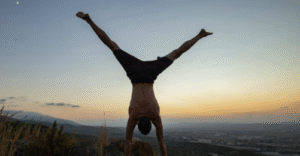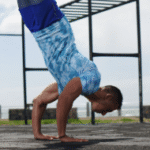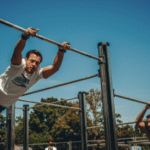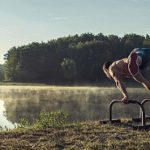Do You Need Equipment for Private Calisthenics Training?
Let’s address the common question: Do you actually need equipment for private calisthenics training? This is a great question, especially given that calisthenics is fundamentally about using your own body weight for resistance.
One of the biggest appeals of calisthenics is its potential minimalism. Unlike weightlifting, which requires access to barbells, dumbbells, and machines, calisthenics primarily uses your body as the load. So, the simple answer is no, you do not strictly need external equipment to begin private calisthenics training and make progress, especially initially. However, the more nuanced answer is that while not essential to start, certain pieces of equipment significantly enhance the training, allow for more balanced development, and become necessary for progressing to intermediate and advanced levels.
The Beauty of Bodyweight: Starting with Zero Equipment
You can achieve a solid foundational workout using absolutely no equipment other than the ground and perhaps a wall. A private coach can design effective beginner programs utilizing variations of push ups (on knees, incline against a wall or furniture), bodyweight squats, lunges, glute bridges, planks, bird dogs, and introductory wall supported handstand holds. This accessibility is fantastic for getting started anywhere, anytime. Your coach will focus on teaching you perfect form and building initial strength and body awareness with just these basics.
Why Equipment Enhances Calisthenics Training Significantly
While you can start without gear, relying solely on bodyweight eventually presents limitations, primarily in two areas: balanced development and progressive overload.
First, Balanced Development. The most significant limitation is the difficulty in performing effective pulling movements without equipment. Pushing exercises (like push ups) are easy to do anywhere, but balancing these with pulling exercises (which work the back and biceps) is crucial for posture, shoulder health, and overall strength balance. This requires something to pull on.
Second, Progressive Overload. While you can make bodyweight exercises harder by changing leverage, tempo, or reps, equipment offers more straightforward and quantifiable ways to increase difficulty or provide assistance, making progress smoother and more measurable.
Third, Exercise Variety and Skill Development. Equipment unlocks a vastly wider range of exercises and is essential for learning many intermediate and advanced calisthenics skills.
Essential Equipment for Balanced Calisthenics
If you plan to pursue calisthenics seriously, even with a coach, one piece of equipment becomes almost essential relatively early on:
1 A Pull Up Bar. This is the most fundamental piece for addressing the lack of pulling movements. It allows for pull ups, chin ups, hanging leg raises, and serves as an anchor for rows using rings or suspension trainers. Options range from inexpensive doorway bars to more permanent wall mounted or freestanding power towers. Access to sturdy overhead structures in parks also works.
Highly Recommended Equipment for Optimal Progress
To truly unlock the potential of calisthenics and facilitate smoother progress, these items are highly beneficial:
1 Gymnastics Rings. Arguably the single most versatile piece of calisthenics equipment. Rings allow for scalable rows, pull ups, dips, push ups, muscle up progressions, core exercises, and much more. The instability adds a significant challenge, building greater stability and strength. They can be hung from a pull up bar, sturdy beam, or tree branch.
2 Parallettes (P Bars). These low bars elevate your hands off the ground, enabling a greater range of motion in push ups, facilitating L sits and tuck sits, providing a stable base for handstand or planche practice (often preferred by those with wrist limitations), and allowing for exercises like deficit push ups.
3 Resistance Bands. Extremely versatile and relatively inexpensive. Bands can be used for assistance (making pull ups or dips easier), added resistance (making push ups or squats harder), mobility exercises, and specific activation drills prescribed by your coach. A set with varying resistance levels is ideal.
Useful Optional Equipment
Other items can further enhance your training but are generally less critical than the above:
A Dip Station if you do not have rings or stable parallel bars.
A Jump Box (Plyo Box) for plyometrics, step ups, or assisting with pistol squats.
An Ab Wheel for advanced core training.
A Weight Vest to add external load to exercises like pull ups, dips, and push ups once bodyweight versions become too easy.
Chalk (magnesium carbonate) for improving grip on bars or rings.
A Yoga Mat for comfort during floor exercises.
How Private Coaching Adapts to Your Equipment Access
This is a key benefit of one on one coaching. Your coach’s job is to create the best possible program for you based on YOUR specific circumstances, including equipment availability.
If you train at home or online, your coach will design workouts utilizing only the equipment you possess. They are skilled at finding effective exercise variations even with minimal gear.
If you train at a park, the coach will structure sessions around the available bars, benches, and open space.
If you train at the coach’s well equipped facility or a commercial gym, you will benefit from the wider range of equipment available there.
A good coach ensures you can make progress regardless of your equipment situation, guiding you on effective bodyweight only progressions if needed.
Conclusion
No, you do not absolutely need equipment to start private calisthenics training, as its foundation lies in bodyweight exercises. You can build a strong base with just the floor and a wall. However, for balanced upper body development (incorporating pulling exercises) and to effectively progress to intermediate and advanced levels and skills, investing in or having access to a pull up bar becomes essential. Items like gymnastics rings, parallettes, and resistance bands are highly recommended as they dramatically increase exercise variety and progression possibilities. Ultimately, your private calisthenics coach will tailor your workouts to maximize results with whatever equipment you have available, ensuring a productive and challenging journey.

Do You Need Equipment for Private Calisthenics Training?
Route
Calisthenics Gym Houston Functional Bodyweight Training
Secondary phone: (346) 483-3195
Email: info@calisthenicsclubhouston.com
URL: https://calisthenicsclubhouston.com/
Monday 6:00 AM - 7:00 PM Tuesday 6:00 AM - 7:00 PM Wednesday 6:00 AM - 7:00 PM Thursday 6:00 AM - 7:00 PM Friday 12:00 PM - 6:30 PM Saturday 9:45 AM - 12:00 PM Sunday 3:00 PM - 5:00 PM





